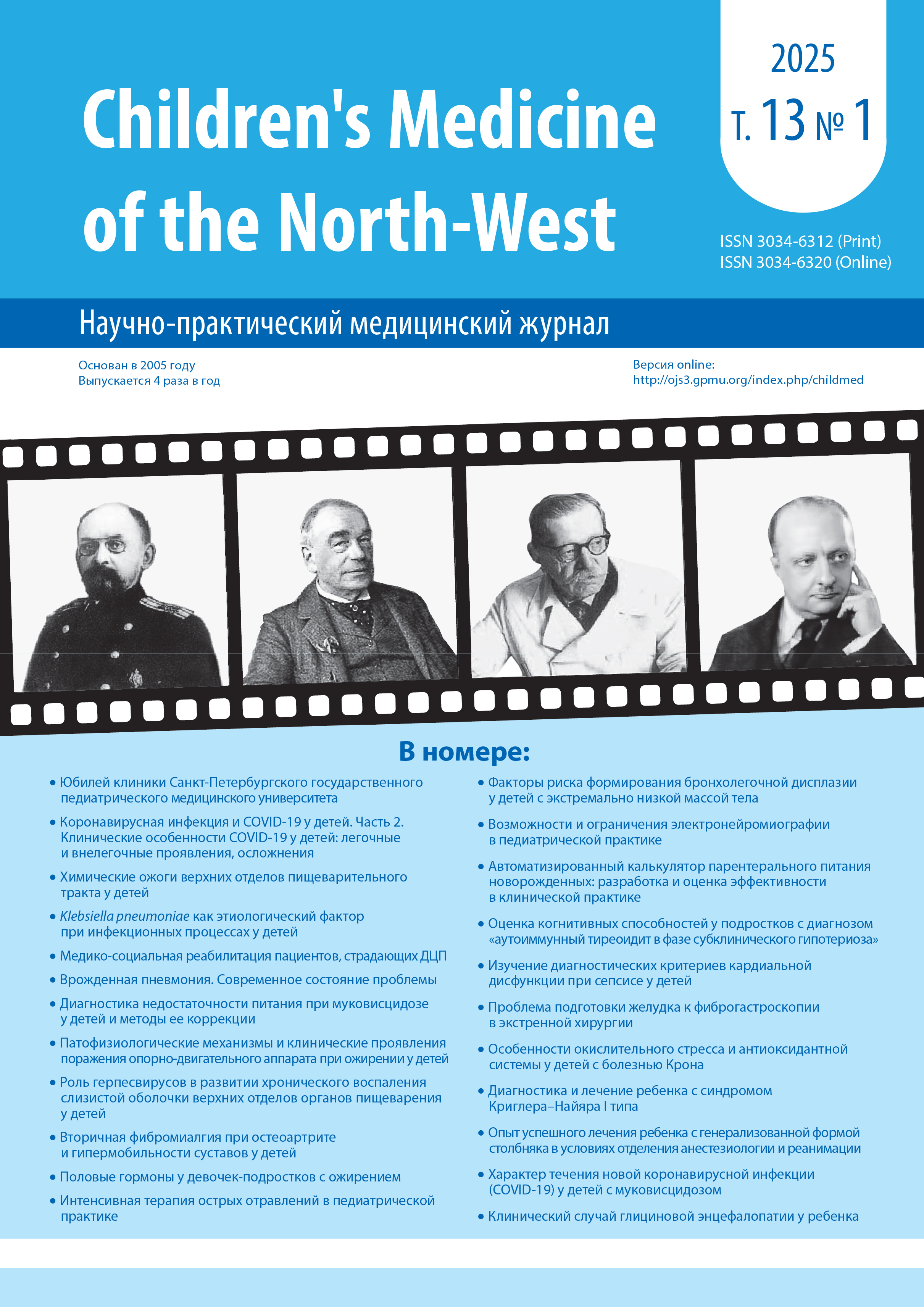THE STUDY OF DIAGNOSTIC CRITERIA FOR CARDIAC DYSFUNCTION WHEN SEPSIS IN CHILDREN
Abstract
Introduction. The sepsis-assoсiated cardiac dysfunction (SACD) remains a poorly understood syndrome in children. The hemodynamic criteria of septic shock adopted by the international consensus of the Society of Critical Care Medicine on January 21, 2024, based on the use of the Phoenix Sepsis scale, were used as the “gold standard”. The aim of the study — to study the diagnostic criteria of SACD for children. Materials and methods. 22 children aged from 1 month to 17 years with suspected sepsis were examined. 2 groups of patients were formed, 1 group with SACD — 5 patients and the second group without SACD — 17 patients. Results. As a result of a comprehensive study, it was revealed that the diagnostic criteria can be clinical and one laboratory criterion. Clinical criteria include: resistant sinus tachycardia 180–200 beats per minute or resistant bradycardia (relative risk (RR) 27; 95% confidence interval (CI) 1.68—431, z — 2.331, the number needed to treat (Harm) (NNT(Harm)) 1.385, 95% CI (Harm) 2.071 — 1.04). The laboratory criterion is the level of N-terminal prohormone of brain natriuretic peptide (NT-PROBNP) in the blood of 2094 pg/ml (sensitivity — 100%, specificity — 100%, area under curve ROC (AUCROC) — 1.0). The statistical power turned out to be higher than 0.8 — the threshold criterion. Conclusion. The study indicates that the identified criteria are sufficiently accurate for the diagnosis of this syndrome.
References
Rudd K.E., Johnson S.C., Agesa K.M., Shackelford K.A., Tsoi D., Kievlan D.R., Colombara D.V., Ikuta K.S., Kissoon N., Finfer S., Fleischmann-Struzek C., Machado F.R., Reinhart K.K., Rowan K., Seymour C.W., Watson R.S., West T.E., Marinho F., Hay S.I., Lozano R., Lopez A.D., Angus D.C., Murray C.J.L., Naghavi M. Global, regional, and national sepsis incidence and mortality, 1990–2017: analysis for the Global Burden of Disease Study. Lancet. 2020;395(10219):200–211. DOI: 10.1016/S0140-6736(19)32989-7.
Schlapbach L.J., Watson R.S., Sorce L.R. et al. International Consensus Criteria for Pediatric Sepsis and Septic Shock. JAMA. 2024;331(8):665–674. DOI: 10.1001/jama.2024.0179.
Миронов П.И., Александрович Ю.С., Трембач А.В., Пшениснов К.В., Лекманов А.У. Сравнительная оценка прогностической способности шкал органной дисфункции pSOFA, PELOD 2 и Phoenix Sepsis Score у детей с сепсисом: ретроспективное наблюдательное исследование. Вестник интенсивной терапии им. А.И. Салтанова. 2024;3:152–160. DOI: 10.21320/1818-474X-2024-3-152-160.
Macido A. A Brief Overview of Sepsis Induced Cardiomyopathy. J Critical Care & Emerg Med. 2024;3(2):1–4. DOI: 10.47363/JCCEM/2024(3)140.
Yang C., Ma J., Guo L., Li B., Wang L., Li M., Wang T., Xu P., Zhao C. NT-Pro-BNP and echocardiography for the early assessment of cardiovascular dysfunction in neonates with sepsis. Medicine. 2022;101:37(e30439). DOI: 10.1097/MD.0000000000030439.
Александрович Ю.С., Иванов Д.О., Павловская Е.Ю., Пшениснов К.В., Быков Ю.В. Кардиальная дисфункция у новорожденных с внутриамниотической инфекцией. Анестезиология и реаниматология. 2023;3:17–23. DOI: 10.17116/anaesthesiology202303117.
van Nassau S.C., van Beek R.H., Driessen G.J., Hazelzet J.A., van Wering H.M., Boeddha N.P. Translating Sepsis-3 Criteria in Children: Prognostic Accuracy of Age-Adjusted Quick SOFA Score in Children Visiting the Emergency Department With Suspected Bacterial Infection. Front Pediatr. 2018;6:266. DOI: 10.3389/fped.2018.00266.
Копытова Е.В., Спичак И.И., Агульник А., Пристанскова Е.А., Киргизов К.И., Жуковская Е.В., Лазарев В.В. Стандартизация подходов к раннему выявлению рисков у пациентов для эскалации терапии в детской гематологии-онкологии: сообщение рабочей группы по внедрению шкалы «РОСРИСК». Результаты анкетирования клиник России и модель организации помощи. Российский журнал детской гематологии и онкологии (РЖДГиО). 2018;5(1):17–33. DOI: 10.17650/2311-1267-2018-5-1-17-33.
Cruz A.T., Lane R.D., Balamuth F., Aronson P.L., Ashby D.W., Neuman M.I., Souganidis E.S., Alpern E.R., Schlapbach L.J. Updates on pediatric sepsis. J Am Coll Emerg Physicians Open. 2020;1(5):981–993. DOI: 10.1002/emp2.12173.
Davis A.L., Carcillo J.A., Aneja R.K., Deymann A.J., Lin J.C., Nguyen T.C., Okhuysen-Cawley R.S., Relvas M.S., Rozenfeld R.A., Skippen P.W., Stojadinovic B.J., Williams E.A., Yeh T.S., Balamuth F., Brierley J., de Caen A.R., Cheifetz I.M., Choong K., Conway E.Jr., Cornell T., Doctor A., Dugas M.A., Feldman J.D., Fitzgerald J.C., Flori H.R., Fortenberry J.D., Graciano A.L., Greenwald B.M., Hall M.W., Han Y.Y., Hernan L.J., Irazuzta J.E., Iselin E., van der Jagt E.W., Jeffries H.E., Kache S., Katyal C., Kissoon N., Kon A.A., Kutko M.C., MacLaren G., Maul T., Mehta R., Odetola F., Parbuoni K., Paul R., Peters M.J., Ranjit S., Reuter-Rice K.E., Schnitzler E.J., Scott H.F., Torres A.Jr., Weingarten-Arams J., Weiss S.L., Zimmerman J.J., Zuckerberg A.L. American College of Critical Care Medicine Clinical Practice Parameters for Hemodynamic Support of Pediatric and Neonatal Septic Shock. Crit Care Med. 2017;45(6):1061–1093. DOI: 10.1097/CCM.0000000000002425.



